A blender is a tool that cannot be missing in the kitchen. This prompted a great variety in the market that offers models with multiple functionalities. The point is that sometimes the variety makes it difficult to make a decision. So here we explain what you should know to choose the right one.
Blenders are household appliances used to grind or beat the food. Vegetables and fruits are generally crushed to make creams, soups, juices, or the like. It is made up of glass with sharp blades that are placed on a motor that drives the blades. Since they emerged, they have become basic utensils for a kitchen.
There are also industrial blenders, which are used in large production companies, or mass-produced food establishments. But these are not for domestic use, although the variety of domestic blenders gives plenty to choose from. We will comment on aspects such as the power, the type of cup, and the different speeds.
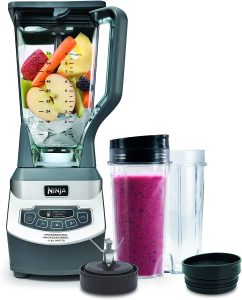
The Important Things
- Blenders are instruments used to grind and crumble food. Juices, creams, and the like are usually prepared. So it is rarely used to grind meat. But in general, it works for a huge variety of preparations, both for dishes and drinks.
- The versatility of the blender has made it a staple for any kitchen. While in its beginnings it was an instrument that few could obtain, over time it has become an essential element to prepare an enormous number of recipes.
- The blenders available on the market are many and varied. These differ in aspects such as power, capacity, type of glass material, or style. All these in addition to changing the profile of the blender intervene in the cost and quality.
The best blenders on the market: our recommendations
Oster Professional Blender
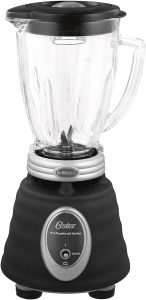
When it comes to home appliances, Oster is often synonymous with quality. With this model they offer a powerful blender with a 600-watt motor and a refractory glass container with a capacity of 1.5 liters. Glass cups tend to have higher resistance to very high or low temperatures, which makes them more versatile.
The blade is of high quality with a drive system called a metal drive, which makes the blender capable of crushing ice without problems. It has 2 blending speeds which allow you to use the right power for what you want to prepare. And the style can match almost any kitchen.
SharkNinja Blender
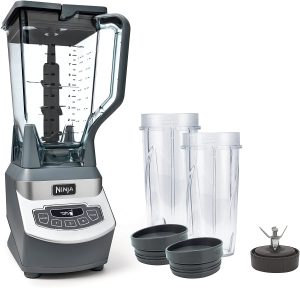
This blender has a modern style and is easy to combine. It has 1100 Watts of power, which allows you to crush even ice, and 72 oz of capacity, the right amount to prepare many different recipes and drinks. It can be washed in the dishwasher, a very important advantage since washing blenders is usually cumbersome.
Includes a couple of cups to store drinks in the fridge or reserve them. They are made of plastic but it is a BPA-free material. So it does not release toxins or substances that are harmful to the human body. The blender jar is marked with measurements, to ensure that the recipe is perfect.
Oster Silver 3-Speed Classic Blender
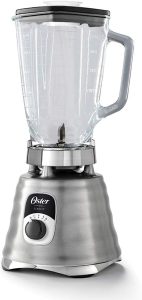
Once again Oster offers a high-quality product with a classic style. This has a power of 600 watts, which together with the Oster stainless steel All Metal Drive blade system allows you to crush ice until it is pulverized. So it is a very versatile blender that will help you prepare many foods and drink recipes.
The glass is made of Boroclass type refractory glass, it has a capacity of 1.25 liters, which is equivalent to 5 cups. It is equipped with 3 different speeds to customize the right blend. It also has a pulse button, which keeps the blender running as long as it is pressed.
Taurus Ragazza Blender
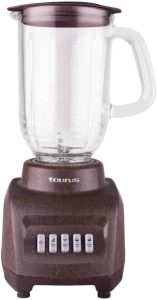
This Taurus blender is a quality, powerful and stylish option to complement any kitchen. The motor is 300W, which is not much power but it is enough to prepare juices and creams. It has a blending speed and a pulse button that keeps the stainless steel blades running as long as it is pressed.
The glass is made of plastic and has a capacity of 1 liter, the equivalent of 4 cups. And the lid has a dosing hole, as all blenders usually do. In addition, the cup fits over the motor using an easy-fit system, which secures the cup and prevents internal gears from being damaged.
Buying Guide: What you need to know about Blenders
Aren’t you craving carrot cream? Or perhaps a better option is pasta soup, in a red broth. These dishes, and many more, can be achieved thanks to one of the most important appliances in the kitchen: the blender. Next, we will talk more about this device.
What are blenders and what advantages do they have?
Blenders are household appliances that have become an essential part of kitchen instruments. And its great versatility makes it a perfect assistant for an innumerable amount of preparations and recipes. So they are used to make drinks such as juices and smoothies, as well as to prepare creams and other smoothies. This utensil is designed so that the blades rotate at different speeds since the appropriate speed depends on the type of food. With what is allowed to adapt the liquefied to the intentions that the user has. It is an essential kitchen tool for many preparations and one that makes home life easier on many levels.
Advantage
⇒ Allows food to be blended
⇒ You can crush ice for drinks
⇒ It is used to make juices
⇒ Facilitates the preparation of many recipes
Disadvantages
⊗ Sharp blades can cause cuts
⊗ Care should be taken when washing
⊗ If the blades are weak they can be broken by ice or the like
⊗ The motor can be damaged by the use
Blenders with glass cups or plastic cups – what should you pay attention to?
Various aspects determine the profile of a blender, among them the power and size of the utensil. However, the first thing to pay attention to is the material of the glass, since this intervenes in the durability and resistance of the device. The glasses are generally made of glass or plastic derivatives. Users tend to prefer glass cups for various reasons. On the one hand, they are more resistant to high temperatures, they are more durable, they do not scratch or mark easily, they are easier to clean, odors do not adhere to them and they maintain a good appearance for longer. But they are also heavier and risk breaking.
For its part, plastic cups have fewer advantages. The main disadvantage is that these plastic materials can have harmful toxins for the body that are released in the food that is liquefied there. They also scratch easily and odors stick to them. However, they are much lighter, which makes them easier to handle.
| Glass cup | Plastic cup |
|---|---|
| Thick glass | Free of toxins and BPA |
| Light in weight | Resistant to high and low temperatures |
| Heat resistance | Suitability for crushing ice and the like |
| Shock support | Easy to clean |
| Scratch and mark proof |
Aspects such as the power and the various speeds that the blender has must also be taken into account. We will tell you about these later.
How do blenders come about?
The blender was invented by an American-based Polish inventor named Stephen J. Poplawski. He was engaged in the development of the blender for almost a decade, during which he created several prototypes and experimented many times. The first successful version was completed in 1922 and patented that same year. This first blender was made up of a stirring component located at the bottom of a cup.
This beat the liquids or drinks that were poured into the cup. But the first versions were not popular in kitchens but in hospitals, since it was suitable for making the creams that patients ate and for grinding food.
With the appearance of tablets and pills, they stopped being used frequently in hospitals and became characteristic household utensils.
How do blenders work?
Blenders consist of a cup made of glass, plastic, or similar materials that have between 3 and 5 very sharp blades on the inside base. This glass is placed on a base inside which there is an electric motor, which makes the blades rotate at high speed.
The foods to be blended are placed in the glass and crushed with the blades. Due to the shape of the propellers, the rotation of the blades at high speed creates a whirlpool inside the glass, with which the food moves and grinds. The motor is usually covered by a plastic or metal casing, on this casing is the axis in which the blender glass fits. And they are AC induction motors.
How much does a blender cost?
The variety of home blenders on the market is huge, and this number increases even more if industrial blenders are included. This same variety causes the price range to be quite wide as well. The cheapest blenders are around $180, these are usually simple and with few speeds.
While the most expensive ones can cost up to $4,000, being professional and of the highest range. But probably the range in which there is the best balance between cost and quality is between $500 – $1200.
Some aspects that intervene in the price of a blender are the power, number of speeds, the size of the mouth, the design, functionalities, and the type of material glass. We will tell you about these.
Where to buy a blender?
One of the great benefits that we have obtained in the 21st century is online shopping. Platforms like Amazon, eBay, Linio, and Mercadolibre are online stores that have as much variety as a physical store. And appliances are part of the products available.
Perhaps it is Amazon that in general has the greatest variety. If you prefer to buy the blender in person, you have the option of going to specialized appliance stores, where there is surely a wide variety of products. The appliance sections of department stores like Cotsco, Woolworth, and Walmart. In these, there are many models and you will get personalized attention.
Purchase criteria, what to take into account to choose a blender?
Before deciding on a model, consider these criteria to choose the right blender for you:
Power
This is an aspect of great importance when considering a blender because it will define what the device will be able to effectively grind. The range usually ranges between 150W and 1000W, all of which are for home use. Although the most common range that covers all needs is between 300W and 600W.
To determine the appropriate range you must think about the use that you will give to the blender. Low powers are not inconvenient when blending juices or soft fruits. But to make creams, blend vegetables or crush ice, more power is needed.
Speeds
The speed at which it is blended is a very important factor for the final result, and at higher speeds, there are more options to achieve the perfect shake or smoothie.
The simplest blenders usually have 1 or 2 speeds, which is not ideal since there is not much room to optimize the blending. While the most sophisticated blenders can have up to 15 and 16 speeds, giving a very wide range. The point is that with the number of speeds the price usually goes up.
It is necessary to measure the use that will be given to it since for domestic use between 6 and 10 speeds is usually more than enough. If you are looking for instruments for a food place, perhaps you should consider something closer to industrial blenders.
Ability
By capacity we mean the measurement in liters of the amount of food that fits in the glass and that the motor can liquefy. This is important, as going over the amount will not only result in overflow but can also stress and damage the motor.
The capacity of domestic blenders varies between 1 liter and 2 liters. There are blenders with more capacity, but they are considered industrial or professional. A blender with a 1.5-liter or 2-liter capacity is sufficient for use in a family home, while a single apartment may be satisfied with a 1-liter one.
Design
The style does not define the quality of the product but ultimately defines your relationship with it. So it is necessary to choose a model that pleases you visually and with a design that is comfortable to use. In this way, you will obtain a practical and functional product, with which you feel good.
Also consider the style of your kitchen, to get a model that fits with the other appliances. There are plenty of blenders out there that are quite neutral looking, designed to suit almost any style. But there are also very colorful designs that are ideal for certain kitchens.
Ease of cleaning
This is an essential aspect for many, and it can define the quality profile of a blender. This is because blenders that can be thoroughly washed are much more hygienic than those that cannot be fully washed. For this reason, blenders that can be disassembled for cleaning are more advantageous.
Another aspect to take into account is its compatibility with the dishwasher. If it is compatible, it has the benefit of saving you from scrubbing it, but if it is not, you have to get your hands wet when washing it.
